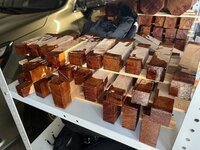Sammy-2016
Member
Hi Group,
Please see the attached picture.
Please tell me if I am doing this properly:
For a good price, I bought a 1.5 thick Mesquite slab which was not dry yet. I cut it up on my table saw into 1.5 x 1.5 x (between 5 & 16" depending on the area of the slab.
I dipped both end grains of each piece into Shellac hoping to slow dry this wood.
Please tell me: should I also paint all the sides since they are freshly cut?
Thank you in advance for any advice
Sammy
Please see the attached picture.
Please tell me if I am doing this properly:
For a good price, I bought a 1.5 thick Mesquite slab which was not dry yet. I cut it up on my table saw into 1.5 x 1.5 x (between 5 & 16" depending on the area of the slab.
I dipped both end grains of each piece into Shellac hoping to slow dry this wood.
Please tell me: should I also paint all the sides since they are freshly cut?
Thank you in advance for any advice
Sammy

